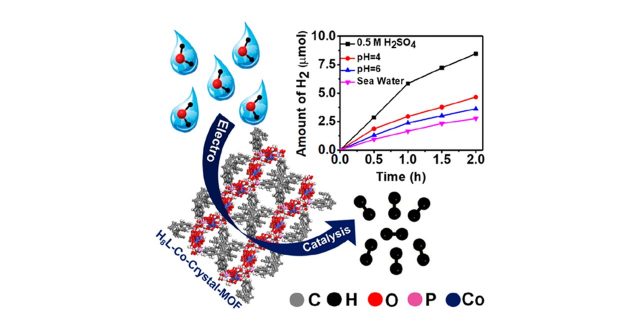The limited stock of classical nonrenewable energy sources has motivated researchers to explore efficient strategies for sustainable and renewable energy production. Hydrogen production via electrochemical water splitting is one of the key solutions that can meet this demand. Today 3d transition metal based nanomaterials offer a huge opportunity in the hydrogen evolution reaction (HER) via electrochemical water splitting. Herein, we report an easy and convenient synthesis route for designing the novel tetradentate phosphonate ligand based metal–organic framework (MOF, H8L-Co-crystal). The material has been characterized by single crystal X-ray diffraction (SXRD), powder XRD, thermogravimetric analysis, scanning electron microscopy, and Fourier transform infrared spectroscopy, and explored in the HER from various mediums including seawater. This single crystal belongs to the monoclinic phase having C2/c space group, with unit cell parameters a = 29.364(8) (Å), b = 12.204(4) (Å), c = 9.925(3) (Å), α = 90° = γ, β = 97.405° (CCDC no. 1922964) and the unit cell volume = 3527.04 Å3. The material H8L-Co-crystal shows very good catalytic activity towards H2 evolution with a low overpotential of 243 mV at a current density 10 mA/cm2 as well as a low Tafel slope of 102 mV/dec in acidic medium, which is comparable to commercial HER catalysts, and one of the best among non-postsynthetically modified MOFs. The electrochemical active surface area (ECSA) data have been measured to explain the high hydrogen evolution rate in different mediums. Density functional theory (DFT) study based on first-principle calculations provides a very useful understanding about the structure–catalytic property relationship and reveals the role of surface active sites toward electrochemical HER.

Cobalt phosphonate metal-organic framework (MOF) enables hydrogen evolution via electrochemical water splitting
WRHI Newsおすすめ
Published
(Sustainable Chemical Resource Production Unit / Dr. Michikazu Hara, Dr. Debraj Chandra and Dr. Manas Bhunia)
“Novel Tetradentate Phosphonate Ligand Based Bioinspired Co-Metal–Organic Frameworks: Robust Electrocatalyst for the Hydrogen Evolution Reaction in Different Mediums”
Cryst. Growth Des. (DOI:10.1021/acs.cgd.0c01275)
For details, click here.
<Abstract>
